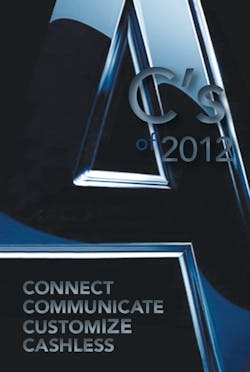Are you ready for the new 4 Cs? Connect, communicate, customize, cashless
Look back 50 years and the vending business was described as the 4 Cs. That’s coffee, cola, candy and cigarettes.
Today we live in a new world of technology and instant communications.
My belief is that we are entering a new era for our industry. The new 4 Cs are connect, communicate, customize and cashless. The challenge for vending, OCS and onsite foodservice operators is how effective we will be in this new 4 Cs world. How quickly will we adapt to these new standards?
We saw dramatic evidence of how retail channels are changing at the 2012 National Retail Federation (NRF) Show in New York City in January.
Paco Underhill, founder and president of Envirosell, a retail consulting firm, was a featured speaker. He said, “The way people shop will change more in the next five years than it has changed in the past 100 years.” Those of us in vending, OCS and onsite foodservice run retail stores. We should be getting ready for even more change in how we sell, what we sell and where we sell.
Stop and think for a moment how much change we’ve seen in how we communicate with one another. And consider how quickly and easily we can access information about where we go to buy something or how to get there.
The iPhone was first introduced on Jan. 9, 2007. In December 2011, over half of Americans had a smart phone – whether it was an iPhone or an Android phone. How did we ever exist before we had these amazing, addictive devices?
In the next two year’s Apple is expected to sell 65.6 million iPads, according to analyst Michael Walkley of Canaccord Genuity, the global investment bank. That will mean more than 100 million iPads sold by the end of 2012. The iPad was introduced in January 2010.
Look at today’s new innovations
We have seen a wave of exceptional new vending equipment coming on the market in recent years. The Coca-Cola Interactive Vending Machine. The Kraft diji-touch candy/snack machine. The Pepsi Social Vending Machine. There are self-serve ordering kiosks for foodservice operations. The self-service markets where payment kiosks and scanners replace the vending machines. The arrival of single-cup brewing equipment and an increasing number of branded product options has been a huge growth driver for OCS operators.
The National Automatic Merchandising Association (NAMA) presented the highlights from its very important market research study at the 2011 OneShow. The most important highlight for me was that young people like vending. One of the key reasons is that they prefer to deal with a machine rather than deal with people when they are shopping. They liked the fact that it is fast, accurate and self-service.
Let me tell you what I learned at the NRF Show in New York City. It relates directly to how shopping will change and what we must do to win the next generation of shoppers. All of this sets up the possibility of an excellent future for us, if we capitalize on it with the most appropriate solutions.
What was new at the NRF Show? In a word, it was vending.
At the Intel booth, there was the new Kraft Jell-O sampling vending machine. Kraft has deployed these machines at supermarkets to offer samples of new products. The machine is “smart.” It has facial recognition capabilities and can recognize a child versus an adult. When sampling food products at retail stores, the demonstrators cannot offer any sample to a child unless the parent permits it first. So the machine can stop a child from getting a sample.
What is interesting is that Intel then changed the front panel to demonstrate the diji-touch candy/snack machine. They showed how it functions and how shoppers can interact with it. They also described how operators can set the screen planogram to maximize the shopping experience.
Interactive video changes shopping
Also at the Intel booth was the new Adidas shopping wall. Rather than simply put shoes on display, there is an interactive, high-resolution image of each shoe. Shoppers can use the touchscreen to “pull out” the shoe, rotate it any direction, get information about the shoe, learn which sizes are available in the store and even request that a store associate come over. That saves time for the shopper and for the store staff. And there is no need for a shoe on the wall for shoppers to see.
“Catch ‘Em and Keep ‘Em: Revitalizing the Store in a Cross-Channel World” was the title of a presentation made by a team from Cisco Internet Business Solutions Group. Their premise is that there is an entirely new level of consumer shopping behavior – it’s called cross channel shopping.
Cisco learned that consumers are engaging heavily in cross-channel shopping and with a greater percentage of shopping going online. That is having a big impact on physical store retailing; e.g., fewer people in the stores, using the stores as showrooms and then price shopping and finishing the purchases at Amazon.com.
So, how can physical store retailers keep and convert consumers in their stores? By providing a more engaging experience and providing ways to shop cross-channel in the store. This lesson applies to our industry – vending, OCS and onsite foodservice.
Cisco calls it the “mashop.” They described it as a “mashing up physical retailing with the best…online content revitalizes stores by creating compelling ‘mashop’ experiences that are not possible (in) either channel alone.”
From this perspective, Cisco created and then tested five “mashop” concepts in the U.S. and U.K. This research was about bringing the virtual experience into the store.
“Catch ‘em” according to Cisco is about making shoppers aware and engaging them. “Keep ‘em” relates to getting shoppers to the store and then maximizing what we sell them when they’re in the store.
My recent articles in Automatic Merchandiser and presentations at NAMA have emphasized that we must do a much better job of communicating with the shoppers at the sites we serve. Our future demands that vending, onsite foodservice and OCS operators must learn and master how to communicate with current and potential shoppers using social media – email, Facebook, Twitter, et. al.
Digital media allows target marketing
In the Cisco concept tests, one of the primary strategies was to deploy a “product viewer.” This was a large, interactive screen to provide product information, views of the product, directions and more. Their research identified how to target specific strategies to enhance appeal to different demographic groups. As you might expect, there were different approaches with more (or less) appeal to shoppers; men versus women or younger versus older.
Don’t forget that the first generation of these applications have already been shown at the NAMA OneShow. Have you seen the Kraft diji-touch snack vending machine, the Coca-Cola Interactive Vending Machine, the Pepsi Social Vending System, the Crane Merchandising Systems touchscreens, the VE Connect interactive touch screen from Vendors Exchange International Inc. and the VendScreen from VendScreen? If you have not seen these important innovations, go out of your way to learn more.
The interactive machines offer vending operators an important benefit that deserves to be mentioned. Whether or not the federal calorie disclosure law requires nutrition information at the point of sale, vending operators will find it in their best interest to provide nutritional information before the purchase is made. This is how to do it. The nutritional data, allergy facts and all related details are easily accessible from the interactive screen.
That does not mean that shoppers must access the information. After all, not every shopper in convenience stores or supermarkets looks at the nutritional panel when they are shopping. But they want the information to be there if they want to see read it.
Interactive shopping goes mainstream
Deployments of interactive shopping experiences are multiplying at a rapid pace. Shoppers of all ages, but especially younger people, like to use these features.
Why is that? In a word it is “gamification.” According to Wikipedia, “Gamification is the use of game design techniques, game thinking and game mechanics to enhance non-game contexts. Typically, gamification applies to non-game applications and processes, in order to encourage people to adopt them, or to influence how they are used.”
For younger people, it is essentially an extension of video games to retail shopping. How has shopping changed? It has become a game – with interactive shopping tools. This interactive experience is what younger expect, maybe even demand, as the way to engage their interest, motivate them to shop and possibly make a purchase.
The new 4-Cs, connect, communicate, customize and cashless, is our new and most important challenge. Our future and maybe even the survival of the vending industry depend on it. Let's consider them one at a time.
Connect: We need online presence for our vending, OCS and onsite foodservice operations.
Communicate: Being online will allow us to reach our audience – shoppers and potential shoppers – with information concerning what we are selling now and will be adding next week. And our audience will be able to reach us with requests with and feedback about how we are doing. The odds are that a Tweet will be available about an out-of-stock before we see it with telemetry.
Customize: This will be our biggest hurdle. We must learn how to provide customized orders for the locations we serve. Subway, the sandwich shop chain, is recognized as providing many healthier selections. Why? It is very simple. Every sandwich (plus salad or breakfast item) is custom-made – assembled based on what the customer wants.
Cashless: This is the next big hurdle. Young people do not carry cash – no coins, no bills. They want to pay with a debit or credit card. Or better yet, with their smart phones. No need to cite the data. The trend is inevitable. We will be a virtually cashless society in the next five to 10 years. Don’t wait – test cashless soon. It won’t work at every site. But it will work at many locations.
The dollar coin is not a solution for our industry. It will not work. It is too heavy. Did you ever carry 17-dollar coins in your pocket? I did recently when I went by train to a meeting in New York City and got 17 -dollar coins and one quarter as change after putting a 20-dollar bill in a parking pay kiosk for a $2.75 fee. I did not like it.
Take a moment to ask yourself these two questions: 1) What will my business be 20 years from now? 2) What am I doing to make sure that we will survive and ultimately be successful 20 years from now? The way people shop is changing rapidly. The way retail stores respond is driving dramatic changes in how stores respond to that change.
The challenge for vending, OCS and onsite foodservice operators is how effective will we be in this new 4-Cs world. We must be relevant for all of the shoppers we serve. Younger shoppers are already living in the world of the new 4-Cs. Let’s catch up to them because they are not waiting for us.
About the Author
Paul Schlossberg is the president of D/FW Consulting, which helps clients merchandise and market products in impulse intense selling environments, such as vending, foodservice and convenience stores. He can be reached at [email protected] or 972-877-2972; www.DFWConsulting.net.
About the Author

Paul Schlossberg
Contributing Editor
Paul Schlossberg is the president of D/FW Consulting, which helps clients merchandise and market products in impulse intense selling environments, such as vending, foodservice and convenience stores. He can be reached at [email protected] or 972-877-2972; www.DFWConsulting.net.
Most recently he has begun writing a bimonthly online column titled "Sell More Stuff" featured on VendingMarketWatch.com.
